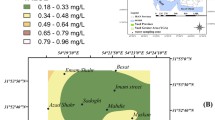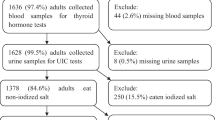Abstract
Background
Artificial neural networks (ANNs) and adaptive neural-fuzzy Inference system (ANFIS) are the best solutions to finding the correlation between some water parameters and human hormones. The correlation between thyroid stimulating hormone (TSH) and drinking water fluoride studied by ANNS and ANFIS models in Yazd city.
Method
In this study, eighty people with thyroid gland disorder and 213 healthy people invited. Their thyroid hormones and fluoride drinking water analyzed.
Results
The result of ANFIS showed R2 = 0.81 for test and R2 = 0.85 for train in all cases and controls data. This results were R2 = 0.73 and R2 = 0.81 for ANNs respectively.
Conclusion
This models can be used as an alternative for show correlation between Drinking Water Fluoride and TSH Hormone and R2 = 0.85 gained from ANFIS was the best.








Similar content being viewed by others
Abbreviations
- ANFIS:
-
Adaptive neural-fuzzy inference system
- ANNS:
-
Artificial neural networks
- NRMSE:
-
Normalized root-mean-square deviation
- R2 :
-
R-squared
- RMSE:
-
root-mean-squared error
- T3:
-
Triiodothyronine
- T4:
-
Thyroxin
- Train GD:
-
Gradient descent
- Train GDA:
-
Gradient descent with adaptive learning rate back propagation
- Train GDX:
-
Variable Learning Rate Back propagation
- Train LM:
-
Levenberg-Marquardt
- Train SCG:
-
Scaled Conjugate Gradient
- TSH:
-
Thyroid stimulating hormone
- YaHS:
-
Yazd Healthy Study
References
Basha PM, Rai P, Begum S. Fluoride toxicity and status of serum thyroid hormones, brain histopathology, and learning memory in rats: a multigenerational assessment. Biol Trace Elem Res. 2011;144:1083–94.
Dey S, Giri B. Fluoride fact on human health and health problems: a review. Med Clin Rev. 2016;2(1):11. https://doi.org/10.21767/2471-299X.100011.
KheradPisheh Z, Ehrampoush MH, Montazeri A, Mirzaei M, Mokhtari M, Mahvi AH. Fluoride in drinking water in 31 provinces of Iran. Expo Health. 2016;8:465–74. https://doi.org/10.1007/s12403-016-0204-z.
Lennon M A, Whelton H, O’Mullane D, Ekstrand J. Fluoride. Rolling revision of the WHO guidelines for drinking-water quality. World Health Organization. 2004.
Peckham S, Awofeso N. Water fluoridation: a critical review of the physiological effects of ingested fluoride as a public health intervention. Sci World J. 2014;2014:293019.
Peckham S, Lowery D, Spencer S. Are fluoride levels in drinking water associated with hypothyroidism prevalence in England? A large observational study of GP practice data and fluoride levels in drinking water. J Epidemiol Community Health. 2015;0:1–6. https://doi.org/10.1136/jech-2014-204971.
Rahmani A, Rahmani K, Dobaradaran S, Mahvi AH. Hamadjani RM, Rahmani H. Child dental caries in relation to fluoride and some inorganic constituents in drinking water in Arsanjan, Iran. Fluoride. 2010;43:179–86.
Dobaradaran S, Mahvi AH, Dehdashti S, Abadi DRV. Drinking water fluoride and child dental caries in Dashtestan, Iran. Fluoride. 2008;41:220–6.
Mahvi AH, Zazoli MA, Younecian M, Nicpour B, Babapour A. Survey of fluoride concentration in drinking water sources and prevalence of DMFT in the 12 years old students in Behshar City. J Med Sci. 2006;6:658–61.
Rahmani A, Rahmani K, Mahvi AH, Usefie M. Drinking water fluoride and child dental caries in Noorabademamasani, Iran. Fluoride. 2010;43:187–93.
Dobaradaran S, Mahvi AH, Dehdashti S. Fluoride content of bottled drinking water available in Iran. Fluoride. 2008;41:93–4.
Dobaradaran S, Mahvi AH, Dehdashti S, Dobaradaran S, Shoara R. Correlation of fluoride with some inorganic constituents in groundwater of Dashtestan, Iran. Fluoride. 2008;42:50–3.
Mahvi AH, Zazoli MA, Younecian M, Esfandiari Y. Fluoride content of Iranian black tea and tea liquor. Fluoride. 2006;39:266–8.
Nouri J, Mahvi AH, Babaei A, Ahmadpour E. Regional pattern distribution of groundwater fluoride in the shush aquifer of Khuzestan County, Iran. Fluoride. 2006;39:321–5.
Zazouli MA, Mahvi AH, Dobaradaran S, Barafrashtehpour M, Mahdavi Y, Balarak D. Adsorption of fluoride from aqueous solution by modified Azolla filiculoides. Fluoride. 2014;47:349–58.
Bazrafshan E, Ownagh KA, Mahvi AH. Application of electrocoagulation process using Iron and aluminum electrodes for fluoride removal from aqueous environment. E-J Chem. 2012;9:2297–308.
Boldaji MR, Mahvi AH, Dobaradaran S, Hosseini SS. Evaluating the effectiveness of a hybrid sorbent resin in removing fluoride from water. Int J Environ Sci Technol. 2009;6:629–32.
Dobaradaran S, Fazelinia F, Mahvi AH, Hosseini SS. Particulate airborne fluoride from an aluminium production plant in arak, Iran. Fluoride. 2009;42:228–32.
World Health Organization. Guidelines for Drinking-water Quality; 2011. Fourth edition, ISBN 978 92 4 154815 1.
Rastogi BA, Monika A. Study of neural network in diagnosis of thyroid. IJCTEE. 2014;4(3):13–6.
Caturegli P, Remigis A, Rose NR. Hashimoto thyroiditis: clinical and diagnostic criteria. Autoimmun Rev. 2014;13:391–7.
Emin Aktan M, Akdogan E, Zengin N, Guney OF, Parlar RE. An artifitial neural network design for determination of Hashimoto’s thyroiditis sub- groups, CBU international on innovations in science and education. 2016:23-25, Prague, Czech Repablic WWW.CBUNI.CZ, WWW.JOURNALS.CZ
Health Information. Endocrine Diseases. Hashimoto's Disease. 2016. www.niddk.nih.gov/health-information/health-topics/endocrine/hashimotos-disease/16.03.2016.
Omitek Z, Burda A, Wojcik W. The use of decision tree induction and artificial neural networks for automatic diagnosis of Hashimoto’s disease. Expert Syst Appl. 2013;40:6684–9.
Sundaram N M, Renupriya V. Artificial neural network classifiers for diagnosis of thyroid abnormalities. International conference on systems, science, control, communication, Eng Technol 2016: 206–211.
Zhang GP, Berardi VL. An investigation of neural networks in thyroid function diagnosis. Health Care Manage Sci. 1998;1:29–37.
Ozyılmaz L, Yıldırım T. Diagnosis of thyroid disease using artificial neural network methods. In: Proceedings of ICONIP’02 9th international conference on neural information processing (Singapore: Orchid Country Club, 2002). 2002, p. 2033–2036.
Soleimanian Gharehchopogh F, Molany M, Dabaghchi MF. Using artificial neural network in diagnosis of thyroid disease: a case study. IJCSA. 2013;3(4):49–61. https://doi.org/10.5121/ijcsa.2013.3405.
Innocent PR, John RI, Garibaldi JM. Fuzzy methods for medical diagnosis. Appl Artif Intell. 2004;19(1):69–98.
Zarandi F, Zolnoori MH, Moin M, Heidarnejad HA. Fuzzy rule-based expert system for diagnosing asthma. Sharif University of Technology. Transaction E. Ind Eng. 2010;17(2):129–42. www.SID.ir
Ghahazi MA, Zarandi F, Harirchian MH, Damirchi-Darasi SR. Fuzzy rule based expert system for diagnosis of multiple sclerosis. IEEE conference on Norbert wiener in the 21st century (21CW), Boston, MA. 2014: 1–5.
Amrollahi Biyouki S, Türksen IB, Fazel Zarandi MH. Fuzzy rule-based expert system for diagnosis of thyroid disease. IEEE. International Conference on Fuzzy Systems. Computational Intelligence in Bioinformatics and Computational Biology (CIBCB). 2015 I.E. Conference. Niagara Falls, ON, Canada 19 October 2015.
Saylam B, Keskek M, Ocak S, Akten AO, Tez M. Artificial neural network analysis for evaluating cancer risk in multinodular goiter. J Res Med Sci. 2013;18(7):554–7.
Er O, Temurtas F, Tanrıkulu AÇ. Tuberculosis disease diagnosis using artificial neural networks. J Med Syst 2013. 2010;34(3):299–302. https://doi.org/10.1007/s10916-008-9241-x.
Castanho MJP, Hernandes F, De Re AM, Rautenberg S, Billis A. Fuzzy expert system for predicting pathological stage of prostate cancer. Expert Syst Appl. 2013;40:466–70.
Takahashi M, Hayashi H, Watanabe Y. Diagnostic classification of schizophrenia by neural network analysis of blood-based gene expression signatures. Schizophr Res. 2010;119:210–8.
Kaya E, Aktan ME, Akdoğan E, Koru AT. Diagnosis of anemia in children via artificial neural network. IJISAE. 2015;3(1):24–7. www.atscience.org/IJISAE
Ebenezer O, Oyebade O, Oyedotun K, Helwan A. Neural network diagnosis of heart disease, Conference Paper 2015. https://doi.org/10.1109/ICABME.2015.7323241.
Lahner E, Intraligi M, Buscema M, CentANNsi M, VANNsella L, Grossi E, et al. Artificial neural networks in the recognition of the presence of thyroid disease in patients with atrophic body gastritis. World J Gastroenterol. 2008;14(4):563–8.
Census of the Islamic Republic of Iran. Islamic Republic of Iran. Archived from the original (excel) on. 2011–11-11. 2006.
Lenore S, Arnold E, Andrew D. Standard methods for the examination of water and wastewater, American public health association, American Water Works Association, water environment federation. The twentieth edition. 4500-F– D. SPADNS Method. 2005;20:140–3.
Boyacioglu MA, Avci D. An adaptive network-based fuzzy inference system (ANFIS) for the prediction of stock market return: the case of the Istanbul stock exchange. Expert Syst Appl. 2010;37:7908–12.
Rezaei Kahkha MR, Piri J. Comparison of artificial neural network and neutral-fuzzy inference system for photo catalytic removal of reactive red dye. Tech J Engine App Sci. 2016;6(1):39–44.
Razia SH, Narasinga Rao MR. Machine learning techniques for thyroid disease diagnosis - a review. Indian J Sci Technol. 2016;9(28) https://doi.org/10.17485/ijst/2016/v9i28/93705, July.
Svalina L, Galzina V, Lujic R, Šimunovic G. An adaptive network-based fuzzy inference system (ANFIS) for the forecasting: the case of close price indices. Expert Syst Appl. 2013;40:6055–63.
Adeli A, Neshat M. A Fuzzy Expert System for Heart Disease Diagnosis in Proceedings of the International Multi Conference of Engineers and Computer Scientists, Hong Kong. March 17–19 2010; 1Hong Kong.
Galletti P, Joyet G. Effect of fluorine on thyroidal iodine metabolism in hyperthyroidism. J Clin Endocrinol. 1958;18(10):1102–10.
Prerana SP, Taneja K. Predictive Data Mining for Diagnosis of Thyroid Disease using Neural Network. Int J Res Manage Sci Technol. 2015;3(2):75–80. Available at www.ijrmst.org
Mirzaei, M., Salehi-Abargouei, A., Mirzaei, M., Mohsenpour, M.A. Cohort profile: the Yazd health study (YaHS): a population-based study of adults aged 20–70 years (study design and baseline population data). Int J Epidemiol 1–10 (2017). https://doi.org/10.1093/ije/dyx231.
Acknowledgements
We acknowledge Yazd Healthy Study participants who gave us their time and drinking water samples.
Funding
This research was supported by Yazd University of Medical Sciences.
Author information
Authors and Affiliations
Contributions
ZKH and MHE was the main investigator, collected the data, MM, MM and AHM supervised the study. MK and RA and HF were advisors of the study. All authors read and approved the final manuscript.
Corresponding authors
Ethics declarations
This study is Compliance with Ethical Standards. This study funded by Environmental Science and Technology Research Center, Department of Environmental Health Engineering, Shahid Sadoughi University of Medical Sciences, Yazd, Iran.
Ethical approval
Case and control people choses with their consent and have been informed about study and they invited for Thyroid hormones test. Their thyroid hormones analyze in Yazd Central Laboratory.
Competing interests
The authors declare that they have no competing interests.
Rights and permissions
About this article
Cite this article
Kheradpisheh, Z., Mahvi, A.H., Mirzaei, M. et al. Correlation between drinking water fluoride and TSH hormone by ANNs and ANFIS. J Environ Health Sci Engineer 16, 11–18 (2018). https://doi.org/10.1007/s40201-018-0290-x
Received:
Accepted:
Published:
Issue Date:
DOI: https://doi.org/10.1007/s40201-018-0290-x




